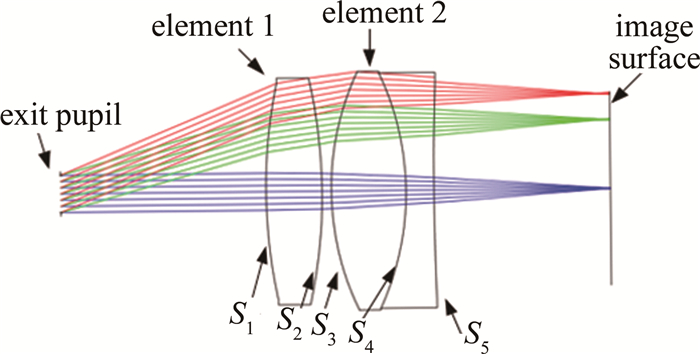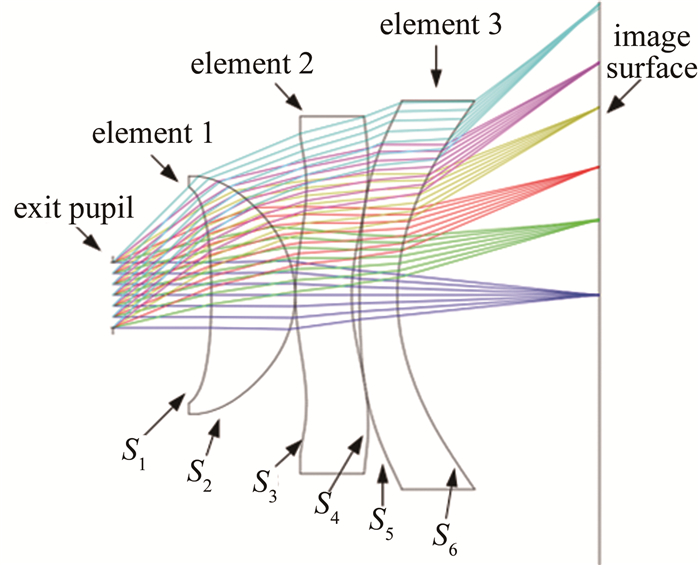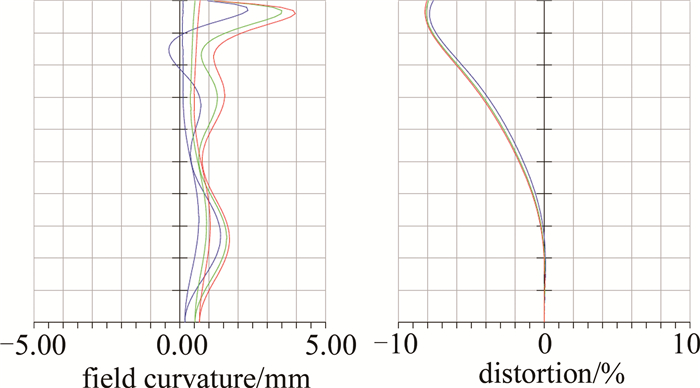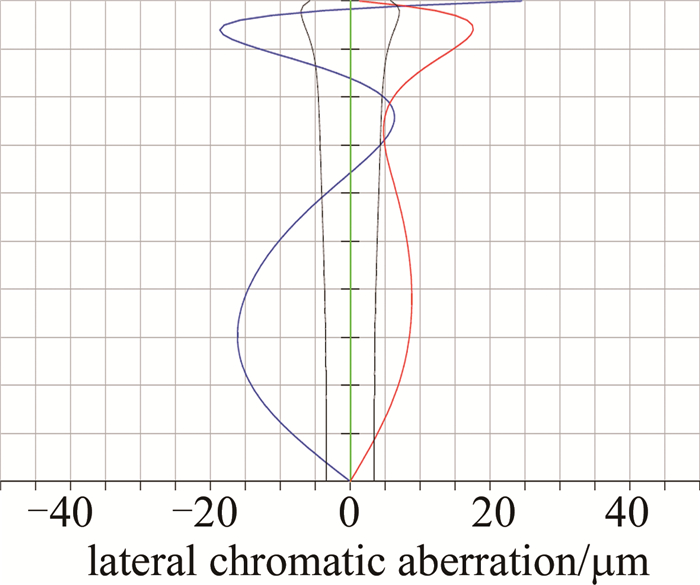HTML
-
虚拟现实技术[1](virtual reality,VR)是利用计算机模拟生成视觉、听觉、触觉等多感官体验,通过辅助设备,佩戴者可与虚拟环境进行交互作用的技术。头戴显示器(head-mounted display,HMD)作为VR技术的关键设备和最佳载体,是一种将图像源输出的图形成像于人眼的目视光学系统,在军事、航天、教育、医学、工业生产、娱乐[2-7]等领域具有极其重要的作用。
随着光学技术与工艺技术的发展与进步,传统的折射型目镜光学系统已无法满足HMD的光学特性要求,于是出现了非球面、自由曲面、折/衍混合等新型HMD光学系统[8]。
2011年,CHENG等人[9]设计了一种离轴自由曲面的拼接HMD光学结构,但系统视场角较小,且人眼偏离入瞳中心时会看到拼接缝隙。2015年,LV等人[10]采用非球面结构,设计了一种具有70°视场角的轻量化HMD光学系统,但系统视场角相对较小。2018年,CHEN[11]设计了一种非球面VR光学系统,但系统出瞳直径和出瞳距离较小且成像质量不高。2019年,LU[12]等人采用菲涅耳透镜加非球面透镜结构,设计了一种基于拼接方法的超大视场的沉浸式VR HMD,但系统出瞳直径较小。
上述部分文献中存在视场角较小、出瞳直径、出瞳距离较小以及成像质量不高等问题,无法完全满足VR HMD的光学特性要求。相比传统球面,非球面具有更大的自由度和灵活性,能够有效校正像差,减少系统透镜数量和提高成像质量[13]。针对VR HMD的光学特性要求,作者采用非球面透镜设计了一种光学系统,系统视场角、出瞳直径和出瞳距里较大,重量较轻,成像质量较好,满足沉浸式VR HMD光学系统要求。
-
沉浸式HMD一般采用非瞳孔成像结构。该结构更加紧凑轻便,且光阑即为人眼瞳孔,光阑大小随瞳孔大小变化。一般采用逆向光学系统设计的方法,系统入瞳即为实际光学系统的出瞳。
人眼的瞳孔直径随着外界环境的光亮度变化范围约为2mm~8mm,HMD出瞳直径过大,会增加设计难度,增加系统重量,本文中瞳孔直径选取为8mm。一般HMD出瞳距离应不小于12mm,出瞳距离选取为12mm。HMD的视场角越大,沉浸感就越强[14],结合人眼特征,本文中设定光学系统全视场角为90°。
畸变是HMD光学系统的重要参量,与视场呈三次方关系,视场越大,畸变就越大,不同视场角的目视光学系统所允许的畸变值不同,本文中将光学系统最大畸变值设定在10%以内。
调制传递函数(modulation transfer function,MTF)能充分反映光学系统实际成像质量,对于目视光学系统而言,MTF设计值要求在奈奎斯特频率处不小于0.1,为获得较好的成像质量,本文中设计将MTF值设定为不小于0.2。
系统重量和总长也是衡量光学系统的重要指标,本文中将重量控制在50g内,总长(包括出瞳距离)控制在60mm内。
HMD光学系统性能具体参量要求如表 1所示。
parameter specification wavelength visible light field of view 90° exit pupil diameter 8mm exit pupil distance 12mm total length <60mm distortion <10% MTF ≥0.2@9.31lp/mm weight <50g Table 1. Performance parameters of HMD optical system
-
根据光学系统性能参量指标,设计中选用对角线为77.6mm的夏普液晶显示屏作为光学系统图像源,像素尺寸为53.7μm×53.7μm,分辨率为1920pixel×1080pixel,分成相同的左右两部分,分别对应左右眼睛。
由光学系统性能参量指标可知,半视场角为45°,图像源屏幕按左右眼分成完全相同的两块,可计算出每个屏幕的对角线为77.6mm,则半像高为38.8mm。光学系统视场角、有效焦距和图像源半像高之间存在以下关系:
式中,f为光学系统的有效焦距,若h为图像源的半像高,θ为光学系统的半视场角,根据(1)式可进一步求出系统的有效焦距为38.8mm。
-
非球面采用偶次非球面,相较于奇次非球面,偶次非球面更容易加工,其表达式为:
式中,z为表面矢高,c为曲面顶点的曲率,c=1/r0, r0为顶点曲率半径,r为光线与曲面交点的径向坐标;k为二次曲面系数,k=e2; α2, α4, α6, α8, α10, α12, α14, α16为非球面系数。
-
初始结构的选取方法有两种: 一种是运用像差理论方法计算求解得出光学系统的初始结构参量;另一种是直接在已有文献中选择与所需的参量指标相近的结构作为初始结构[15]。
作者从已有资料上选取凯尔纳目镜作为光学系统的初始结构,图 1为初始结构光路图。其半视场为22.5°,出瞳直径为4mm,出瞳距离为22mm,有效焦距为28mm。
显然,初始结构的视场角、出瞳直径和出瞳距离与HMD光学系统性能参量要求具有较大差距,需要对其进一步优化。
-
通过ZEMAX光学软件在初始结构的基础上进行多次结构调整和系统优化,大致可分为以下3个过程。
(1) 将初始结构系统焦距缩放至38.8mm;将系统中S1~S5 5个光学面的曲率半径、透镜1和透镜2的间距以及厚度作为变量,并添加相应操作数控制其范围,如有效焦距操作数控制系统有效焦距大小;通过最大畸变操作数,将系统最大畸变控制在10%内;逐步调整出瞳直径、出瞳距离和视场角,在视场角增加一定程度后手动分离双胶合透镜。
(2) 引入偶次非球面增加系统的变量和自由度,替换玻璃材料,改变材料折射率和阿贝数;继续调整视场角和出瞳距离,添加相应操作数控制系统二次项系数值、表面曲率、表面间距离,非球面系数取到10阶即可,阶数过高会使面型过于复杂。
(3) 添加相应操作数控制系统的像差,进一步提升系统成像质量。如通过子午衍射调制传递函数操作数和弧矢衍射调制传递函数操作数控制系统传递函数值,y方向主光线横向像差操作数和减法运算操作数控制垂轴色差,广义子午场曲操作数和广义弧矢场曲操作数控制场曲。
图 2为最终得到的系统光路图。图 3为光学系统3-D模型切面图。光学系统视场角为90°,出瞳直径为8mm,出瞳距离为12mm,系统总长为59.3mm,单目重量为33.67g,满足光学系统性能参量要求。透镜1为正透镜,透镜2和透镜3为负透镜,S1~S6均为偶次非球面。表 2为光学系统的透镜材料参量。其中COC(copolymers of cycloolefin)为环烯烃共聚物; DKP-A1为以芳香族为原料的聚酯树酯。表 3为光学系统的非球面参量。其中conic为圆锥曲线函数,the nth order为非球面的高阶系数。
No. material index abbe density/(g·cm-3) element 1 COC 1.533 56.227 1.020 element 2 OKP-A1 1.649 21.451 1.210 element 3 OKP-A1 1.649 21.451 1.210 Table 2. Material parameters of optical system lens
conic the 2nd order the 4th order the 6th order the 8th order the 10th order S1 37.935 0.000 -1.495×10-5 -2.685×10-7 3.526×10-9 -1.522×10-11 S2 -0.154 0.000 -2.954×10-6 1.508×10-7 -2.170×10-11 1.724×10-12 S3 -11.883 0.000 -2.604×10-5 -7.817×10-9 -2.977×10-11 1.957×10-13 S4 -5.355 0.000 -3.490×10-5 2.005×10-8 -2.722×10-11 -1.532×10-14 S5 -94.629 0.000 2.331×10-5 -2.406×10-8 -1.263×10-11 -8.860×10-15 S6 -0.044 0.000 -1.184×10-5 1.009×10-8 -1.389×10-11 -1.419×10-14 Table 3. Optical system aspheric parameters
2.1. 图像源
2.2. 非球面设计
2.3. 初始结构
2.4. 优化过程
-
图 4为光学系统调制传递函数(optical transfer function, OTF)曲线图。在奈奎斯特频率(9.31lp/mm)处,全视场内调制传递函数值均优于0.272,边缘视场和中心视场成像质量较好。图中, 分别表示了现场角为0°, 13.50°, 22.50°, 31.82°, 38.25°, 45.00°时子午光线传递函数值T(每一个角度值对应的前一条竖线)和弧矢光线传递函数值S(所对应的后一条竖线)。图 5为光学系统场曲/畸变图。从图中可以看出,最大场曲出现在0.97倍视场处,最大畸变为8.17%。图 6为光学系统垂轴色差曲线图。最大垂轴色差出现在0.94倍视场处,为36.2μm,小于一个像素尺寸。以上所述完全满足VR HMD光学系统参量要求。
-
光学系统在加工和装配过程中会存在一定的误差,使产品偏离设计结果。为提高产品的成像质量,降低加工装配难度和成本,需要进行合理的公差分配,增加光学系统的可行性[16],因此,光学系统设计完成后,对其进行公差分析具有十分重要的意义。
常用的公差有表面公差和元件公差,具体包括曲率半径、厚度、x/y偏心、x/y倾斜、折射率、阿贝数等公差[17]。此外,通过MATLAB软件对高次非球面的面形精度进行数值分析,建立各面型矢高矩阵,采用非线性最小二乘法拟合出偶次非球面方程,将相应系数输入到ZEMAX中,分析公差对光学系统的成像质量的影响。
公差分配好后,通过ZEMAX光学软件进行Monte Carlo分析。本文中计算分析了200个Monte Carlo样本,实际上每一个样本就是一个模拟加工、装调后的光学系统,通过计算得到光学系统视场内9.31lp/mm处的平均MTF值。表 4为光学系统的公差分配表。表中峰谷值(peak-to-valley, PV)用来表示面型精度。表 5为平均MTF值Monte Carlo分析结果。
type tolerances surface tolerances radius/mm ±0.01 thickness/mm ±0.05 decenter x/mm ±0.02 decenter y/mm ±0.02 tilt x/(°) ±0.02 tilt y/(°) ±0.02 index ±0.001 abee/% ±0.5 element tolerances decenter x/mm ±0.02 decenter y/mm ±0.02 tilt x/(°) ±0.02 tilt y/(°) ±0.02 surface accuracy PV/μm S2 0.19 S3 0.52 S4 0.41 S5 0.29 S6 0.83 S7 1 Table 4. Tolerance distribution table of optical system
Monte Carlo analysis MTF value field 1(0°) field 2(13.5°) field 3(22.5°) field 4(31.815°) field 5(38.25°) field 6(45°) >90% 0.33145 0.57739 0.27418 0.35553 0.29823 0.24950 0.21730 >80% 0.33513 0.58377 0.28219 0.36636 0.30420 0.25775 0.23047 >50% 0.3455 0.59278 0.30030 0.38006 0.31381 0.27928 0.26116 >20% 0.35466 0.60065 0.31483 0.38966 0.32330 0.30321 0.30798 >10% 0.35847 0.603317 0.32443 0.39385 0.32805 0.31568 0.33064 Table 5. Monte Carlo analysis results
表 5中给出了Monte Carlo数据大于90%, 80%, 50%, 20%, 10%的产品所能达到的传递函数。从数据可以看出,按照表 4中的公差分配设置加工、装调后,在9.31lp/mm处,90%以上的产品MTF平均值优于0.33145,90%以上的产品在视场6处的传递函数优于0.21730,均满足光学系统传递函数设计要求值。
-
基于沉浸式虚拟现实头戴显示器光学特性要求,本文中选用彩色液晶显示屏作为图像源,采用非球面结构,通过ZEMAX光学软件设计了一种三片式虚拟现实头戴显示器光学系统,并对光学系统进行像质评价和公差分析。设计的光学系统视场角为90°,出瞳直径为8mm,系统总长小于60mm,系统重量为33.67g,最大畸变为8.17%,9.31lp/mm处的MTF值均优于0.272,成像质量较好,满足沉浸式VR HMD的光学系统要求;其Monte Carlo分析结果表明,光学系统的平均MTF值均满足传递函数要求,进一步验证了光学系统的合理性与可行性。
本文中设计的头戴显示器光学系统结果与参考文献[11]相比,视场角增加了10°,出瞳距离与出瞳直径均增加了4mm,图像源的像素更高,畸变、垂轴色差以及MTF值均有改善,成像质量更好。

 Map
Map










 DownLoad:
DownLoad:




